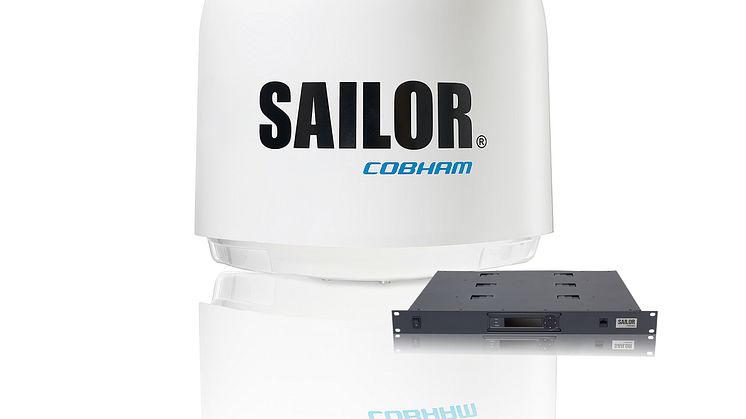
Press release -
Cobham SATCOM: SAILOR 900 VSAT High Power Launches
New model is the most cost effective Ku-band antenna on the market and releases potential for higher throughput uplinks even in tropical climates
Copenhagen, Denmark – Cobham SATCOM has developed a new version of its market-leading SAILOR 900 Very Small Aperture Terminal (VSAT) Ku-band antenna, featuring a new Block Up Converter (BUC). The antenna, designed by Cobham, makes it easier and less costly to ensure high availability of service as there is no need for additional hardware. It also delivers the potential for satcom service providers to deliver higher uplink bandwidths. The innovative 20W BUC in the new SAILOR 900 VSAT High Power antenna also ensures reliable operation in warm, humid climates without the need for air conditioning systems in the antenna, despite the radiated power level increase from 8W to 20W.
The ever increasing demand for higher data throughput on the uplink to satellites (‘sending’ from the vessel) has triggered demand for antenna systems with higher power RF performance. Because the new 20W BUC is designed in-house for perfect integration with the SAILOR 900 VSAT, Cobham SATCOM has ensured high quality control, resulting in reliable, high performance operation in all environments.
The new SAILOR 900 VSAT High Power offers satcom service providers a new alternative to the standard SAILOR 900 VSAT to meet requirements from shipping companies for high Service Level Agreements (SLA), especially when a dual antenna configuration is required due to obstructions that cannot be overcome by setting up blocking zones.
SAILOR 900 VSAT High Power retains the same installation benefits that established it as a leading choice for maritime satcom service providers when it was first released in 2011. Every SAILOR 900 VSAT High Power antenna system comes factory-tested, balanced and ready-to-go with standardised top quality RF and the requirement for only one cable between antenna and below-deck. This time and cost saving approach combined with high operational reliability has positioned SAILOR 900 VSAT as the most cost effective Ku-band antenna on the market to deploy.
All SAILOR Ku-Band VSAT antennas have been tested to work on HTS services, including Intelsat’s EpicNG. Additionally, even with its unique higher power BUC, the SAILOR 900 VSAT High Power is prepared for conversion from Ku- to Ka-band operation on services like Inmarsat Fleet Xpress® or Maritime Ka-Band on THOR 7 from Telenor Satellite, should the end-user request it. Updated electronics, a precision reflector dish and radome tuned for optimum performance on both Ku- and Ka-band frequencies ensure that SAILOR 900 VSAT High Power is an incredibly flexible solution.
With its new in-house designed BUC, Cobham SATCOM is able to offer the new benefits of SAILOR 900 VSAT High Power to existing SAILOR 900 VSAT users, through specially developed SAILOR Conversion Kits. Customers can move from SAILOR 900 VSAT to SAILOR 900 VSAT High Power and additionally from SAILOR 900 VSAT High Power to SAILOR 100 GX. This provides high levels of flexibility for service providers, enabling them to offer a cost-effective migration path to alternative satellite services in order to meet their customers’ changing requirements.
For further information, please contact:
Cobham SATCOM
Jens Ewerling
Director, Maritime Broadband
+45 39558200
jens.ewerling@cobham.com
Related links
About Cobham SATCOM
Providing dependable communications and internet access anywhere under the most demanding conditions.
Our satellite and radio communication terminals perform in the most challenging and remote environments on land, at sea and in the air.
We design and manufacture these high performance products under the AVIATOR, EXPLORER, SAILOR and Sea Tel brands providing customers with outstanding performance, value and support through our global sales and service network.
About Cobham
The most important thing we build is trust.
Cobham is a leading global technology and services innovator, respected for providing solutions to the most challenging problems, from deep space to the depths of the ocean.

